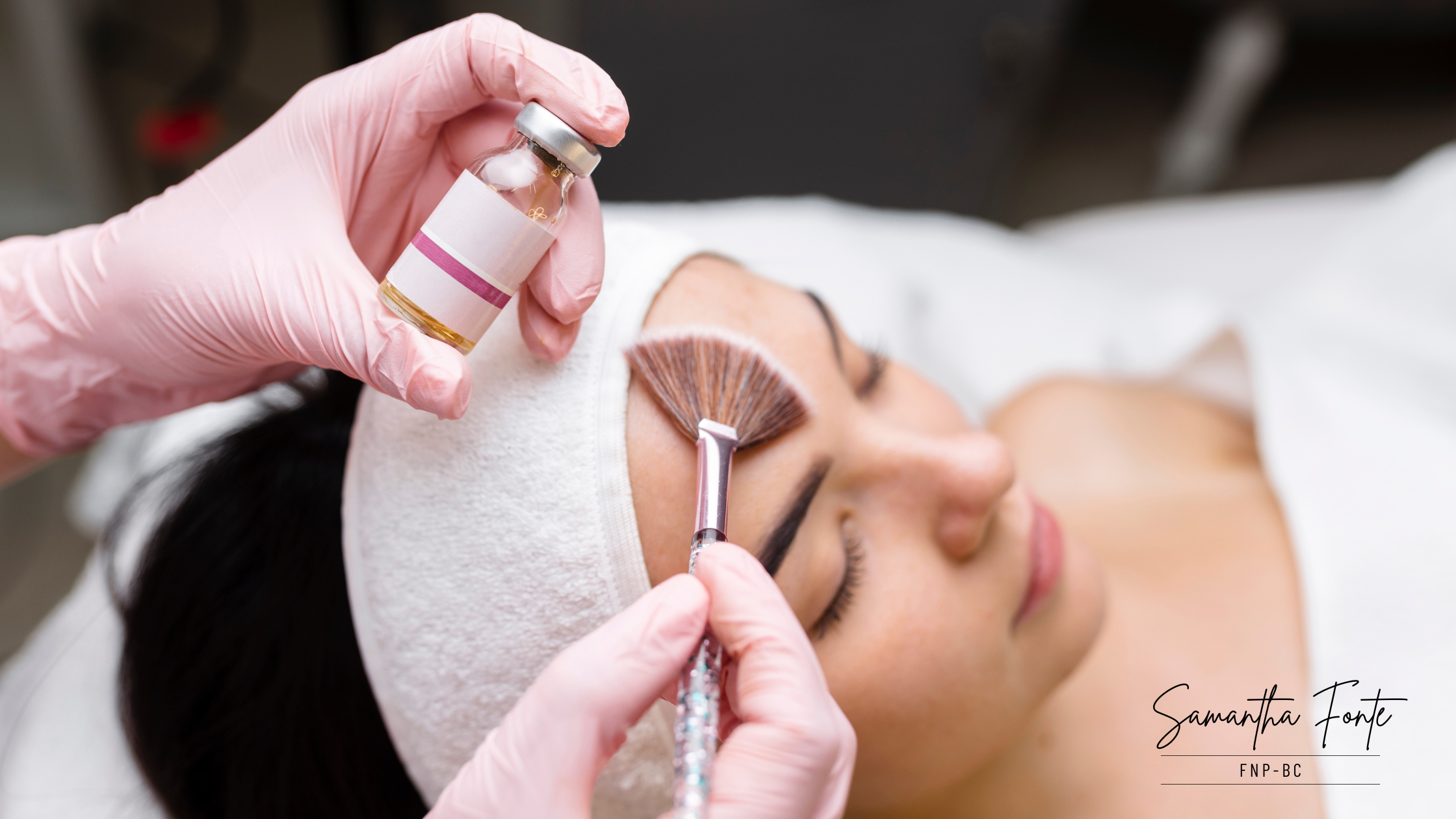Chemical Peel Science: How It Works for Skin Renewal
The Science Behind Chemical Peels
Chemical peel science explains one of the most proven methods for renewing the skin's surface and improving overall appearance. Chemical peels use a controlled solution of exfoliating acids. They remove dull and damaged skin layers. This process helps the body produce more collagen. As a result, you get a smoother, brighter, and more even complexion.
This treatment isn't new. Dermatologists have used peels for many years. However, the science behind chemical peels is still changing. Today's products are safer, more accurate, and can be customized. They target problems like sun damage, uneven skin tone, acne scars, and rough skin texture.
In Miami's sunny climate, where UV exposure and humidity can accelerate skin aging, chemical peels offer a science-backed way to refresh your complexion and maintain youthful radiance.
What Is a Chemical Peel?
A chemical peel is a professional skincare treatment that applies a chemical solution—often containing glycolic acid, lactic acid, salicylic acid, or trichloroacetic acid—to the skin. These solutions cause a controlled exfoliation, gently lifting away dead cells from the outermost layer of skin.
Once those cells are removed, the body begins repairing and regenerating new, healthier skin cells. At the same time, the process stimulates collagen production, which improves elasticity and firmness.
Chemical peels are available in different strengths and depths, suitable for various concerns, from dullness and fine lines to acne scars and pigmentation.
For professional treatment options and personalized recommendations, visit Nuceria's Miami Chemical Peels.
The Science Behind Chemical Peels
It's helpful to know how the skin works to understand chemical peel science. The skin renews in cycles, shedding dead cells naturally every 28 to 40 days. However, this process slows down with age, sun exposure, and pollution, causing buildup and dullness.
Chemical peels accelerate cell turnover through controlled chemical exfoliation. Acids dissolve the bonds between old cells, allowing them to slough off more easily. This triggers the skin's repair response:
- Exfoliation – Removal of damaged surface cells.
- Regeneration – Growth of new cells with improved skin texture.
- Stimulation – Increased collagen production and elastin for firmer, smoother skin.
By combining exfoliation and regeneration, chemical peels deliver results that topical products alone can't match.
Types of Chemical Peels
1. Superficial Peels
Light or superficial peels are ideal for beginners or those with mild concerns. They target the outermost layer of skin using mild acids such as glycolic acid or lactic acid. These peels brighten dull complexions, refine uneven skin tone, and improve mild sun damage with minimal downtime.
2. Medium Peels
Medium-depth peels, often using trichloroacetic acid (TCA), penetrate deeper layers to treat more visible sun exposure, fine lines, and pigmentation. Expect light flaking for several days as the skin renews.
3. Deep Peels
Deep peels use stronger acids like phenol and reach deeper dermal layers to correct severe wrinkles or scars. These treatments require professional supervision and more prolonged recovery, but the results are transformative.
A professional consultation ensures the correct depth and formula for your skin type and goals.
What Skin Concerns Do Chemical Peels Treat?
Chemical peels effectively address a variety of concerns, including:
- Sun damage and UV-related pigmentation
- Uneven skin tone or discoloration
- Fine lines and wrinkles
- Acne and post-acne scars
- Dull or rough skin texture
- Enlarged pores and blackheads
Each peel type works differently, but all rely on chemical peel science to stimulate renewal and restore balance.
Who Is a Good Candidate?
Most skin types can benefit from chemical peels, especially individuals who want to:
- Minimize sun exposure damage
- Improve uneven skin tone
- Soften fine lines or acne scars
- Smooth rough skin texture
- Boost radiance and clarity
However, people with sensitive skin, active infections, or certain medical conditions should consult a licensed provider before treatment.
The Skin's Healing Process
After a peel, your skin goes through a visible transformation:
- Days 1–2: Mild redness or tightness as the peel begins working.
- Days 3–5: Peeling or flaking as old skin sheds.
- Days 5–7: Fresh, smooth skin becomes visible.
- Weeks 2–4: Deeper regeneration continues as collagen production increases.
It's essential to keep skin hydrated and avoid sun exposure during this stage. Moisturizers, SPF, and gentle cleansers help maintain results.
When Will You See Results?
Timing depends on the type of peel:
- Superficial peels: Brighter, more radiant skin in 3–5 days.
- Medium peels: Noticeable improvement in tone and texture in 1–2 weeks.
- Deep peels: Significant renewal after 2–3 weeks, with ongoing improvement for months.
Because chemical peels stimulate collagen production, benefits continue to build long after the initial treatment.
How Chemical Peels Work for Common Issues
Sun Damage
Peels break down damaged cells, allowing new, healthier ones to surface and improving sun damage and age spots.
Uneven Skin Tone
Accelerating exfoliation peels even out pigmentation and promote a more uniform complexion.
Acne and Texture
Glycolic acid and salicylic acid peels clear pores, reduce breakouts, and refine rough skin texture.
Fine Lines and Aging
Stimulating collagen production helps plump the skin and reduce visible signs of aging.
Pre- and Post-Treatment Care
Before the Peel
- Avoid exfoliants or retinoids for 5–7 days
- Protect your skin from sun exposure
- Stay hydrated and use gentle products
After the Peel
- Keep skin moisturized
- Apply SPF daily
- Avoid picking at peeling skin
- Skip intense workouts or heat for a few days
Proper care ensures safe healing and optimal results.
Long-Term Benefits of Chemical Peels
Regular treatments help maintain clear, youthful skin by:
- Increasing collagen production and elasticity
- Improving tone and texture
- Reducing sun damage
- Diminishing fine lines and pores
- Encouraging continuous cell renewal
With consistent sessions, chemical peels can significantly transform your skin's health and appearance.
FAQs
How do chemical peels work?
They exfoliate damaged layers, stimulate regeneration, and boost collagen production for smoother, brighter skin.
How soon will I see results?
You'll notice an initial glow within days, with deeper improvements over weeks.
What does the skin experience afterward?
Mild redness and flaking as new, refreshed skin emerges.
Are chemical peels safe for all skin types?
Most are, but a consultation ensures the best formula for your unique needs.
How often can I get a peel?
Superficial peels: every 4 weeks; medium peels: every 3–6 months.
Conclusion
Chemical peel science combines dermatology and advanced exfoliation to achieve lasting skin renewal. By removing dull surface layers and stimulating collagen production, chemical peels reveal smoother, brighter, and more even skin.
For expert guidance and customized treatments, explore Nuceria's Chemical Peels in Miami and read more at Transform Your Skin: Explore the Power of Chemical Peels.
Request an appointment here: https://mynuceria.com or call Nuceria Health at (305) 398-4370 for an appointment in our Miami office.
Check out what others are saying about our services on Yelp: Wellness Center in Miami, FL.







